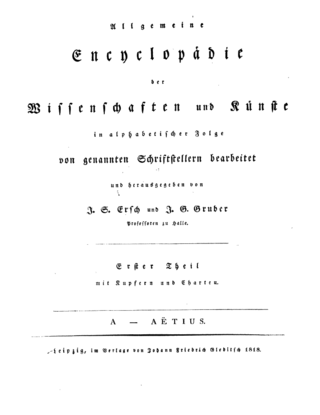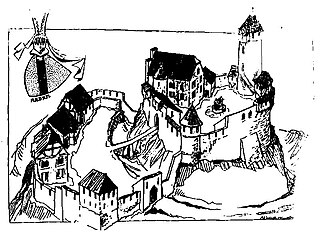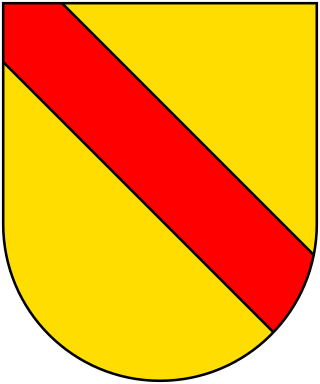
The Allgemeine Encyclopädie der Wissenschaften und Künste was a 19th-century German encyclopaedia published by Johann Samuel Ersch and Johann Gottfried Gruber, therefore also known as the "Ersch-Gruber." One of the most ambitious encyclopaedia projects ever, it remains uncompleted.

The Hochburg is a castle ruin situated between the city of Emmendingen and the village of Sexau in the region of Baden, located in the southwest of Germany. It was presumably built in the 11th century and was originally known as castle Hachberg. The line of nobles known as the Margraves of Baden-Hachberg most likely derive their name from this castle and before it was razed by the French it was the second largest fortification in Baden.

Sausenburg Castle is a ruined German castle on the edge of the Black Forest, just north of the town of Kandern in Baden-Württemberg, between the villages of Sitzenkirch and Malsburg-Marzell. The castle was originally the stronghold of the lords of Sausenburg, and is built on a hill, 665 metres high, known as the Sausenberg.

Rötteln Castle, located above the Lörrach suburb of Haagen, lies in the extreme southwest corner of the German state of Baden-Württemberg, just 10 kilometres north-east of the Swiss City of Basel. The fortification was one of the most powerful in the southwest, and today, it is the third largest castle ruin in Baden.

The Margraviate of Baden-Durlach was an early modern territory of the Holy Roman Empire, in the upper Rhine valley, which existed from 1535 to 1771. It was formed when the Margraviate of Baden was split between the sons of Margrave Christopher I and was named for its capital, Durlach. The other half of the territory became the Margraviate of Baden-Baden, located between the two halves of Baden-Durlach. Baden-Durlach became Lutheran during the Protestant Reformation, unlike Baden-Baden, which remained Catholic. Baden-Durlach occupied Baden-Baden from 1594 to 1622, but was driven out after being defeated at the Battle of Wimpfen, during the Thirty Years' War (1618-1648). The territory was ravaged during the Nine Years' War (1688-1697). Following the extinction of the Baden-Baden line in 1771, the Baden-Durlach inherited their territories and reunited the Margraviate of Baden. The reunified territory was caught up in the French Revolutionary and Napoleonic Wars, emerging in 1806 as the Grand Duchy of Baden.

Margrave Philip I of Baden took over the administration of his father's possessions Baden (Baden-Baden), Durlach, Pforzheim and Altensteig and parts of Eberstein, Lahr and Mahlberg in 1515 and ruled as governor until he inherited the territories in 1527. From 1524 till 1527, he also acted as an imperial governor in the second Imperial Government.
His official title was Margrave of Baden-Sponheim.

Margrave Philip of Hachberg-Sausenberg was the son of the Margrave Rudolf IV of Hachberg-Sausenberg and Margaret of Vienne. Philip reigned in 1487–1503 as Margrave of Hachberg-Sausenberg and Count of Neuchâtel. From 1466 he called himself Lord of Badenweiler.

Marie Hedwig Auguste of Sulzbach was a Countess Palatine of Sulzbach by birth and by marriage, Archduchess of Austria and by her second marriage, Duchess of Saxe-Lauenburg.
Margrave Rudolf IV of Hachberg-Sausenberg was the son the Margrave William of Hachberg-Sausenberg and his wife Elisabeth of Montfort-Bregenz.

Margrave William of Hachberg-Sausenberg was the son of Margrave Rudolf III of Hachberg-Sausenberg and Anne of Freiburg-Neuchâtel. He ruled from 1428 to 1441, and abdicated on 21 June 1441 in favor of his infant sons, Rudolf IV and Hugo. As they were still infants, his cousin Count John of Freiburg-Neuchâtel took over the government as regent.
Frederick IV of Fürstenberg-Heiligenberg, a member of the Swabian noble house of Fürstenberg, was Count (Graf) of Fürstenberg-Heiligenberg, today a part of Baden-Württemberg, Germany. He was the son of Count Joachim of Fürstenberg (1538–1598) and his wife, Countess Anna of Zimmern.

Margrave Rudolf III of Hachberg-Sausenberg (1343–1428) was the son of Margrave Rudolf II of Hachberg-Sausenberg and Catherine of Thierstein. He inherited Hachberg-Sausenberg when his father died in 1352. As he was a minor at the time, his uncle Otto I acted as regent. When Rudolf II came of age, he and Otto I ruled jointly, until Otto's death in 1384. Rudolf III is considered the most important of the Margraves of Hachberg-Sausenberg.

Margrave Rudolf II of Hachberg-Sausenberg(medieval: Rudolf II of Hachberg-Susenberg) (1301–1352) was the son of Margrave Rudolf I of Hachberg-Sausenberg and his wife Agnes, the heiress of Otto of Rötteln. After their elder brother Henry died in 1318, Rudolf II and his younger brother Otto I took up government in Rötteln and Sausenberg. They moved their seat of government from Sausenburg Castle to Rötteln Castle. In the fall of 1332, troops from the City of Basel besieged Rötteln Castle, because one of the brothers had stabbed the mayor of Basel. The conflict was settled after mediation by the nobility of the city and the margraviate.

Otto I, Margrave of Hachberg-Sausenberg was a member of the House of Zähringen. He was the ruling Margrave of Rötteln and Sausenberg from 1318 until his death.

Margrave Rudolf I of Hachberg-Sausenberg (d.1313) was the son of Margrave Henry II of Hachberg and Anne of Üsenberg. He married in 1298 or 1299 to Agnes, the heiress of Otto of Rötteln. In 1306 he founded the side-line Hachberg-Sausenberg at Sausenburg Castle, a castle which the Margraves of Hachberg had built in 1240 on top of Mount Sausenberg. His elder brother Henry III continued the main Baden-Hachberg line at Hochburg castle in Emmendingen.

Henry, Margrave of Hachberg-Sausenberg (1300-1318) was the son of Margrave Rudolf I of Hachberg-Sausenberg and his wife Agnes, who was the daughter and heiress of Otto of Rötteln. In 1312, when he was still a minor, he inherited his father's possessions. After he came of age in 1315, his uncle Lüthold II of Röttlen gave him the Lordship of Rötteln. Lüthold II died in 1316.

Henry II, Margrave of Baden-Hachberg was the ruling Margrave of Baden-Hachberg from 1231 to 1289.
Agnes of Landsberg was a German noblewoman. She was the third child of Conrad II (1159–1210), Margrave of Lusatia, and his wife, Elisabeth, the daughter of Mieszko III the Old (1126–1202), Duke of Poland. She was a daughter-in-law of Henry the Lion.

Henry I, German: Heinrich I from the House of Zähringen was margrave of Baden-Hachberg. He was the founder of the Baden-Hachenberg branch.
















